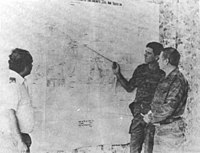
Photo from wikipedia
The use of proxy groups and intermediary wars is rooted in the superpower competition during the Cold War. Since the collapse of the bipolar system, the main actors in West… Click to show full abstract
The use of proxy groups and intermediary wars is rooted in the superpower competition during the Cold War. Since the collapse of the bipolar system, the main actors in West Asia have increasingly used these groups as a key factor in redefining the Middle East's regional order rather than direct military intervention to achieve national goals. The main question raised in this study is "what is the reason for the I. R. Iran's attention to proxy groups in the Middle East after the collapse of the bipolar international system and what role do these groups play in Iran's national security strategy?" In response should be stated that the place of proxy groups in Iranian foreign policy strategy has been to institutionalize some sort of balance against US threats in the peripheral areas. In other words, Iran's support for these aligned groups in the region is not aimed at exporting revolution, supporting liberation movements, and forming a Shiite crescent; rather, according to a strategic logic, it is a kind of asymmetric battle to defend the Islamic Republic's existence against American plots in West Asia. Although, Iran has attempted to use this capacity to shape a regional order based on its revolutionary-Islamic ideas for some time. Theoretical framework of research is "Neoclassical realism and the balance of threat theory", the research method is descriptive-analytical and data collection tool is library and documentary.
Journal Title: World Politics
Year Published: 2021
Link to full text (if available)
Share on Social Media: Sign Up to like & get
recommendations!